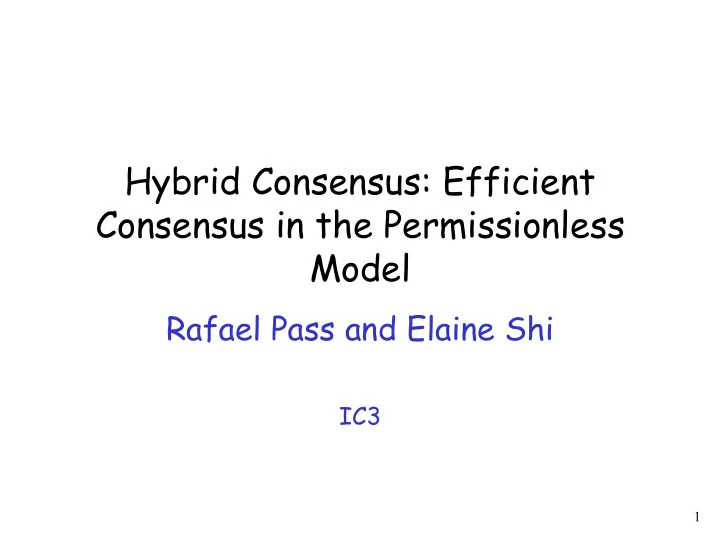

Hybrid Consensus: Efficient Consensus in the Permissionless Model Rafael Pass and Elaine Shi IC3 1
Blockchains Satoshi Nakamoto, 2009 Public database Shared & maintained between network participants Blockchain agreement protocol Periodically agree on a new block of data Bloc Bloc Bloc Bloc k 4 k 3 k 2 k 1
The Blockchain Agreement Problem Set of N computational nodes Blo Blo Blo No inherent identity ck ck ck No PKI 3 2 1 Agree on a block Includes a set of new transactions (or data) Two properties Agreement Validity: all transactions satisfy some validity conditions
Scalability Issue 1 MB block per 10 Support limited computations mins Several DoS attacks recently 3-7 TXs per second Demand from Practice: 1,200 - 50,000 TXs/s
Byzantine Agreement p 2 p p 1 3 p p 5 4 •Complete graph •permissioned 5
Agreement: Every correct node chooses the same value If all the correct nodes have the same input, that input must be the value chosen 6
Existing protocols are not scalable x Known static identity set High x O(n 2 ) messages ? BFT Transaction rate Protocols x Constant TX rate x Re-parameterization is not a long term solution Nakamoto Low Consensus Number of nodes Large 7 Small
Hybrid Consensus Idea • Use PoW chain to elect a static committee honest nodes run the blockchain for csize + λ • blocks where csize = Θ ( λ ) denotes the targeted committee size. honest nodes would remove the trailing, • unstablized λ blocks from its local chain, and call the miners of the first csize blocks the BFT committee. • Run BFT to agree on a new block
Blocks h,nonce,TXs PoW block h’, Σ ,TXs BFT block Σ : a set of signatures | Σ | ≥ csize/3 R-th committee 9
Step 1: Identity establishment Solve PoW ID = H ( h , Nonce, txs) < D Random seed Difficulty for the PoW The last csize confirmed blocks define members in a committee
Step 2: Propose BFT blocks Run a classical Byzantine agreement protocol -Members agree & sign on one valid BFT block -Each committee serves for a period of time to generate csize PoW blocks, e.g. 1 day. - Broadcast the block to the network
When each committee has at least C members? Each committee has O( λ ) O( λ 2 ) messages =>scalable
Security guarantees Due to the consistency property of PoW chain, all honest nodes agree on the same BFT committee. Due to the chain quality property of PoW chain, with appropriate overall parameters, we can ensure that more than 2/3 of the committee members are honest which is sufficient to ensure the security of the permissioned BFT protocol.
Security guarantees Due to the chain growth property of the pow chain, it will not take too long for the BFT committee to form
T HANK YOU 15
Recommend
More recommend